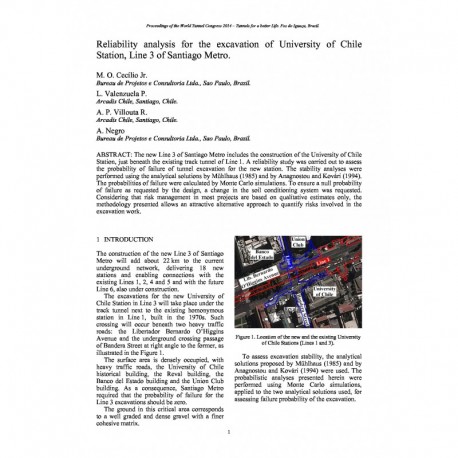Cart
0
0
No document
0,00 €
Total
Document successfully added to your shopping cart
Quantity
Total
There are 0 items in your cart.
There is 1 item in your cart.
Total documents
Total shipping
To be determined
Total
Search & filter
Search for a publication
Search & filter

Reliability analysis for the excavation of University of Chile Station, Line 3 of Santiago Metro
pap272
M. O. Cecílio Jr. / L. Valenzuela P. / A. Negro / A. P. Villouta
The new Line 3 of Santiago Metro includes the construction of the University of Chile Station, just beneath the existing track tunnel of Line 1. A reliability study was carried out to assess the probability of failure of tunnel excavation for the new station. The stability analyses were performed using the analytical solutions by Mühlhaus (1985) and by Anagnostou and Kovári (1994). The probabilities of failure were calculated by Monte Carlo simulations. To ensure a null probability of failure as requested by the design, a change in the soil conditioning system was requested. Considering that risk management in most projects are based on qualitative estimates only, the methodology presented allows an attractive alternative approach to quantify risks involved in the excavation work. 1 INTRODUCTION The construction of the new Line 3 of Santiago Metro will add about 22 km to the current underground network, delivering 18 new stations and enabling connections with the existing Lines 1, 2, 4 and 5 and with the future Line 6, also under construction. The excavations for the new University of Chile Station in Line 3 will take place under the track tunnel next to the existing homonymous station in Line 1, built in the 1970s. Such crossing will occur beneath two heavy traffic roads: the Libertador Bernardo O’Higgins Avenue and the underground crossing passage of Bandera Street at right angle to the former, as illustrated in the . The surface area is densely occupied, with heavy traffic roads, the University of Chile historical building, the Reval building, the Banco del Estado building and the Union Club building. As a consequence, Santiago Metro required that the probability of failure for the Line 3 excavations should be zero. The ground in this critical area corresponds to a well graded and dense gravel with a finer cohesive matrix. To assess excavation stability, the analytical solutions proposed by Mühlhaus (1985) and by Anagnostou and Kovári (1994) were used. The probabilistic analyses presented herein were performed using Monte Carlo simulations, applied to the two analytical solutions used, for assessing failure probability of the excavation.


